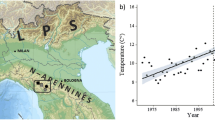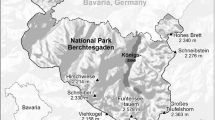Abstract
There is growing interest in what controls the present distribution of terrestrial vegetation in Antarctica because of the potential use of biodiversity as an indicator or predictor of the effects of climate change. Recent advances in knowledge of distribution and ecophysiological performance of terrestrial vegetation means that an initial analysis of the potential influence of temperature is now possible. Regressions of species numbers of lichens, mosses and hepatics on latitude and mean annual temperature (standard macroclimatic data) were carried out, and the terrestrial vegetation in Antarctica could be divided into two zones. The microenvironmental zone lies south of around 72°S, and biodiversity (richness and location) is uncoupled from the macroenvironment and is, instead, determined by the occasional coincidences of warmth, water, light and shelter. The macroenvironmental zone lies north of about 72°S, and biodiversity (richness, cover and growth) is strongly positively linked to mean annual temperature; species numbers increase at about 9–10% per K (24.0, 9.3 and 1.8 species for lichens, mosses and hepatics, respectively) probably due to improved water availability through increased precipitation and longer active period (monthly degree-days also reach zero at about 72°S) allowing greater productivity, completion of metabolic processes and a switch from survival to growth strategies. Cyanobacterial lichens appear to be a special case and may be expanding after being forced into northerly refugia. Warming will cause a southward movement of the boundary between the two zones but distribution in the microenvironmental zone will remain determined by local coincidences of environment and resources.








Similar content being viewed by others
References
Brabyn L, Beard C, Seppelt RD, Rudolph ED, Türk R, Green TGA (2006) Quantified vegetation change over 42 years at Cape Hallett, East Antarctica. Antarct Sci 18:561–572
Bromwich DH, Guo Z (2004) Modelled Antarctic precipitation. Part I: spatial and temporal variability. J Clim 17:427–447
Cannone N, Seppelt RD (2008) A preliminary floristic classification of southern and northern Victoria Land vegetation, continental Antarctica. Antarct Sci 20:553–562
Convey P, Stevens MI (2007) Antarctic biodiversity. Science 317:1877–1878
Convey P, Gibson JAE, Hillenbrand CD, Hodgson DA, Pugh PJA, Smellie JL, Stevens MI (2008) Antarctic terrestrial life—challenging the history of the frozen continent? Biol Rev 83:103–117
Fowbert JA, Smith RIL (1994) Rapid population increases in native vascular plants in the Argentine Islands, Antarctic Peninsula. Arct Alpine Res 26:290–296
Green TGA, Schroeter B, Seppelt RD (2000) Effect of temperature, light and ambient UV on the photosynthesis of the Moss Bryum argenteum Hedw. in Continental Antarctica. In: Davison W, Howard-Williams C, Broady P (eds) Antarctic ecosystems: models for a wider ecological understanding. The Caxton Press, Christchurch, pp 165–170
Green TGA, Kulle D, Pannewitz S, Sancho LG, Schroeter B (2005) UV-A protection in mosses growing in continental Antarctica. Polar Biol 28:822–827
Green TGA, Schroeter B, Sancho LG (2007) Plant life in Antarctica. In: Pugnaire FI, Valladares F (eds) Handbook of functional plant ecology. CRC Press, Taylor & Francis Group, London, pp 389–433
Green TGA, Sancho LG, Türk R, Seppelt RD, Hogg ID (2011) High diversity of lichens at 84°S, Queen Maud Mountains, suggests preglacial survival of species in the Ross Sea region Antarctica. Polar Biol. doi:10.1007/s00300-011-0982-5 (Online First)
Harrisson PM, Rothery P (1988) Net CO2 exchange in relation to thallus moisture and temperature in two fruticose lichens Usnea antarctica and Usnea aurantiaco-atra from the maritime Antarctic. Polarforschung 58:171–179
Hawes I, Torricelli G, Stevens MI (2010) Haplotype diversity in the Antarctic springtail Gressittacantha terranova at fine spatial scales—a Holocene twist to a Pliocene tale. Antarct Sci 22:766–773
Howard-Williams C, Peterson D, Lyons WB, Cattaneo-Vietti R, Gordon S (2006) Measuring ecosystem response in a rapidly changing environment: the Latitudinal Gradient Project. Antarct Sci 18:465–471
Howard-Williams C, Hawes I, Gordon S (2010) The environmental basis of ecosystem variability in Antarctica: research in the Latitudinal Gradient Project. Antarct Sci 22:591–602
Kappen L, Schroeter B, Green TGA, Seppelt RD (1998) Microclimatic conditions, meltwater moistening, and the distributional pattern of Buellia frigida on rock in a southern continental Antarctic habitat. Polar Biol 19:101–106
Lange OL, Green TGA (2005) Lichens show that fungi can acclimate their respiration to seasonal changes in temperature. Oecologia 142:11–19
Lange OL, Kappen L (1972) Photosynthesis of lichens from Antarctica. Antarct Res Ser Antarct Terr Biol 20:83–95
Longton RE (1988) The biology of polar bryophytes and lichens. Cambridge University Press, Cambridge
Lud D, Moerdijik TCW, Van de Poll WH, Buma AGJ, Huiskes AHL (2002) DNA damage and photosynthesis in Antarctica and Arctic Sanionia uncinata (Hedw.) Loeske under ambient and enhanced levels of UV-B radiation. Plant Cell Environ 25:1579–1589
Lud D, Schlensog M, Schroeter B, Huiskes AHL (2003) The influence of UV-B radiation on light dependent photosynthetic performance in Sanionia unicinata (Hedw.) Loeske in Antarctica. Polar Biol 26:225–232
Newsham KK, Hodgson DA, Murray WA, Peat HJ, Smith RIL (2002) Response of two Antarctic bryophytes to stratospheric ozone depletion. Glob Change Biol 8:972–983
Nolan L, Hogg ID, Stevens MI, Haase M (2006) Fine scale distribution of mtDNA haplotypes for the springtail Gomphiocephalus hodgsoni (Collembola) corresponds to an ancient shoreline in Taylor Valley, continental Antarctica. Polar Biol 29:813–819
Novis PM, Whitehead D, Gregorich EG, Hunt JE, Sparrow AD, Hopkins DW, Elberling B, Greenfield LG (2007) Annual carbon fixation in terrestrial populations of Nostoc commune (Cyanobacteria) from an Antarctic dry valley is driven by temperature regime. Glob Change Biol 13:1224–1237
Øvstedal DO, Smith RIL (2001) Lichens of Antarctica and South Georgia: a guide to their identification and ecology. Cambridge University Press, Cambridge
Pannewitz S, Schlensog M, Green TGA, Sancho LG, Schroeter B (2003) Are lichens active under snow in continental Antarctica? Oecologia 135:30–38
Pannewitz S, Green TGA, Maysek K, Schlensog M, Seppelt RD, Sancho LG, Türk R, Schroeter B (2005) Photosynthetic responses of three common mosses from continental Antarctica. Antarct Sci 17:341–352
Peat HJ (1998) The Antarctic Plant Database: a specimen and literature based information system. Taxon 47:85–93
Peat HJ, Clarke A, Convey P (2007) Diversity and biogeography of the Antarctic flora. J Biogeogr 34:132–146
Sancho LG, Pintado A, Valladares F, Schroeter B, Schlensog M (1997) Photosynthetic performance of cosmopolitan lichens in the maritime Antarctic. Biblio Lichenol 67:197–210
Sancho LG, Green TGA, Pintado A (2007) Slowest to fastest: extreme range in lichen growth rates supports their use as an indicator of climate change in Antarctica. Flora 202:667–673
Schlensog M, Schroeter B, Sancho S, Pintado A (1997) Effect of strong irradiance on photosynthetic performance of the melt-water dependent cyanobacterial lichen Leptogium puberulum (Collemataceae) Hue from the maritime Antarctic. Biblio Lichenol 67:235–246
Schroeter B (1991) Untersuchungen zu Primärproduktion und Wasserhaushalt von Flechten der maritimen Antarktis unter besonderer berücksichtigung von Usnea antarctica DuRietz. PhD thesis, Universität Kiel
Schroeter B (1994) In situ photosynthetic differentiation of the green algal and the cyanobacterial photobiont in the crustose lichen Placopsis contortuplicata. Oecologia 98:212–220
Schroeter B (1997) Grundlagen der Stoffproduktion von Kryptogamen unter besonderer Berücksichtigung der Flechten. Habilitation thesis, Universität Kiel. [Unpublished]
Schroeter B, Kappen L, Moldaenke C (1991) Continuous in situ recording of the photosynthetic activity of Antarctic lichens—established methods and a new approach. Lichenologist 23:253–265
Schroeter B, Green TGA, Kappen L, Seppelt RD (1994) Carbon dioxide exchange at subzero temperatures. Field measurements on Umbilicaria aprina in Antarctica. Cryptog Bot 4:233–241
Schroeter B, Olech A, Kappen L, Heitland W (1995) Ecophysiological investigations of Usnea antarctica in the maritime Antarctic. I. Annual microclimatic conditions and potential primary production. Antarct Sci 7:251–260
Schroeter B, Kappen L, Green TGA, Seppelt RD (1997a) Lichens and the Antarctic environment: effects of temperature and water availability on photosynthesis. In: Lyons WB, Howard-Williams C, Hawes I (eds) Ecosystem processes in Antarctic ice-free landscapes. Balkema, Rotterdam, pp 103–117
Schroeter B, Kappen L, Schulz F (1997b) Long-term measurements of microclimatic conditions in the fruticose lichen Usnea aurantiaco-atra in the maritime Antarctic. Actas del V. Simposio de Estudios Antárticos (Barcelona), pp 63–69
Schroeter B, Kappen L, Sancho LG (2000) Seasonal variation in the carbon balance of lichens in the maritime Antarctic: long-term measurements of photosynthetic activity in Usnea aurantiaco-atra. In: Davison W, Howard-Williams C, Broady P (eds) Antarctic ecosystems: models for wider ecological understanding. The Caxton Press, Christchurch, pp 258–262
Schroeter B, Green TGA, Pannewitz S, Schlensog M, Sancho LG (2010) Fourteen degrees of latitude and a continent apart: comparison of lichen activity over two years at continental and maritime Antarctic sites. Antarct Sci 22:681–690
Schroeter B, Green TGA, Pannewitz S, Schlensog M, Sancho LG (2011) Summer variability, winter dormancy: lichen activity over 3 years at Botany Bay, 77°S latitude, continental Antarctica. Polar Biol 34:13–22
Selkirk PM, Scotnicki ML (2007) Measurement of moss growth in continental Antarctica. Polar Biol 30:407–413
Seppelt RD, Türk R, Green TGA, Moser G, Pannewitz S, Sancho LG, Schroeter B (2010) Lichen and moss communities of Botany Bay, Granite Harbour, Ross Sea, Antarctica. Antarct Sci 22:691–702
Skaugen TE, Tveito OE (2004) Growing-season and degree-day scenario in Norway for 2021–2050. Clim Res 26:221–232
Smith RIL (1994) Vascular plants as bioindicators of regional warming in Antarctica. Oecologia 99:322–328
Smith RIL (1996) Introduced plants in Antarctica: potential impacts and conservation issues. Biol Conserv 76:135–146
Snell KRS, Kokuban T, Griffiths H, Convey P, Hodgson DA, Newsham KK (2009) Quantifying the metabolic cost to an Antarctic liverwort of responding to an abrupt increase in UVB radiation exposure. Glob Change Biol 15:2563–2573
Stevens M, Greenslade P, Hogg ID, Sunnucks P (2006) Southern Hemisphere Springtails: could any have survived glaciation of Antarctica? Mol Biol Evol 23:874–882
Torricelli G, Frati F, Convey P, Telford M, Carapelli A (2010) Population structure of Friesea grisea (Collembola, Neanuridae) in the Antarctic Peninsula and Victoria Land: evidence for local genetic differentiation of pre-Pleistocene origin. Antarct Sci 22:757–765
Turner J, Bindschadler RA, Convey P, Di Prisco G, Fahrbach E, Gutt J, Hodgson DA, Mayewski PA, Summerhayes CP (2007) Antarctic climate change and the environment. SCAR publication, ISBN 978-0-948277-22-1
Walton DHW (1984) The terrestrial environment. In: Laws RM (ed) Antarctic ecology. Academic Press, London
Wharton DA (2002) Life at the limits: organisms in extreme environments. Cambridge University Press, ISBN 0521782120
Winkler JB, Kappen L, Schulz F (2000) Snow and ice as an important ecological factor for the cryptogams in the maritime Antarctic. In: Howard-Williams C, Davison W (eds) Antarctic ecosystems: models for wider ecological understanding. The Caxton Press, Christchurch, pp 220–224
Acknowledgments
We are grateful to Antarctica New Zealand (AntNZ) for logistical support over several years as part of the Latitudinal Gradient Project coordinated by Shulamit Gordon. Logistics support was also provided by the Australian Antarctic Programme, the Spanish National Antarctic Program and the US Coastguard Reserve. These are all gratefully thanked. The New Zealand Foundation for Research, Science and Technology (FRST), the University of Waikato Vice Chancellor’s Fund and the Department of Biological Sciences, University of Waikato provided financial support. During completion of the research, TGAG and LGS were supported by the FRST grant, ‘Understanding, valuing and protecting Antarctica’s unique terrestrial ecosystems: predicting biocomplexity in Dry Valley ecosystems,’ and TGAG and LGS by the Spanish Education Ministry grants POL2006- 08405 and CTM2009- 12838-C04-01 and BS by the Deutsche Forschungsgemeinschaft (DFG SCHR 473/4-3). Special thanks go to Prof. Ute Harms, IPN, Kiel, Germany for support to BS.
Author information
Authors and Affiliations
Corresponding author
Additional information
This article is an invited contribution on Global Tipping Points (Global Change and Antarctic Terrestrial Biodiversity) and part of the SCAR EBA programme. I. Hogg and D. Wall (Guest Editors).
Rights and permissions
About this article
Cite this article
Green, T.G.A., Sancho, L.G., Pintado, A. et al. Functional and spatial pressures on terrestrial vegetation in Antarctica forced by global warming. Polar Biol 34, 1643–1656 (2011). https://doi.org/10.1007/s00300-011-1058-2
Received:
Revised:
Accepted:
Published:
Issue Date:
DOI: https://doi.org/10.1007/s00300-011-1058-2




